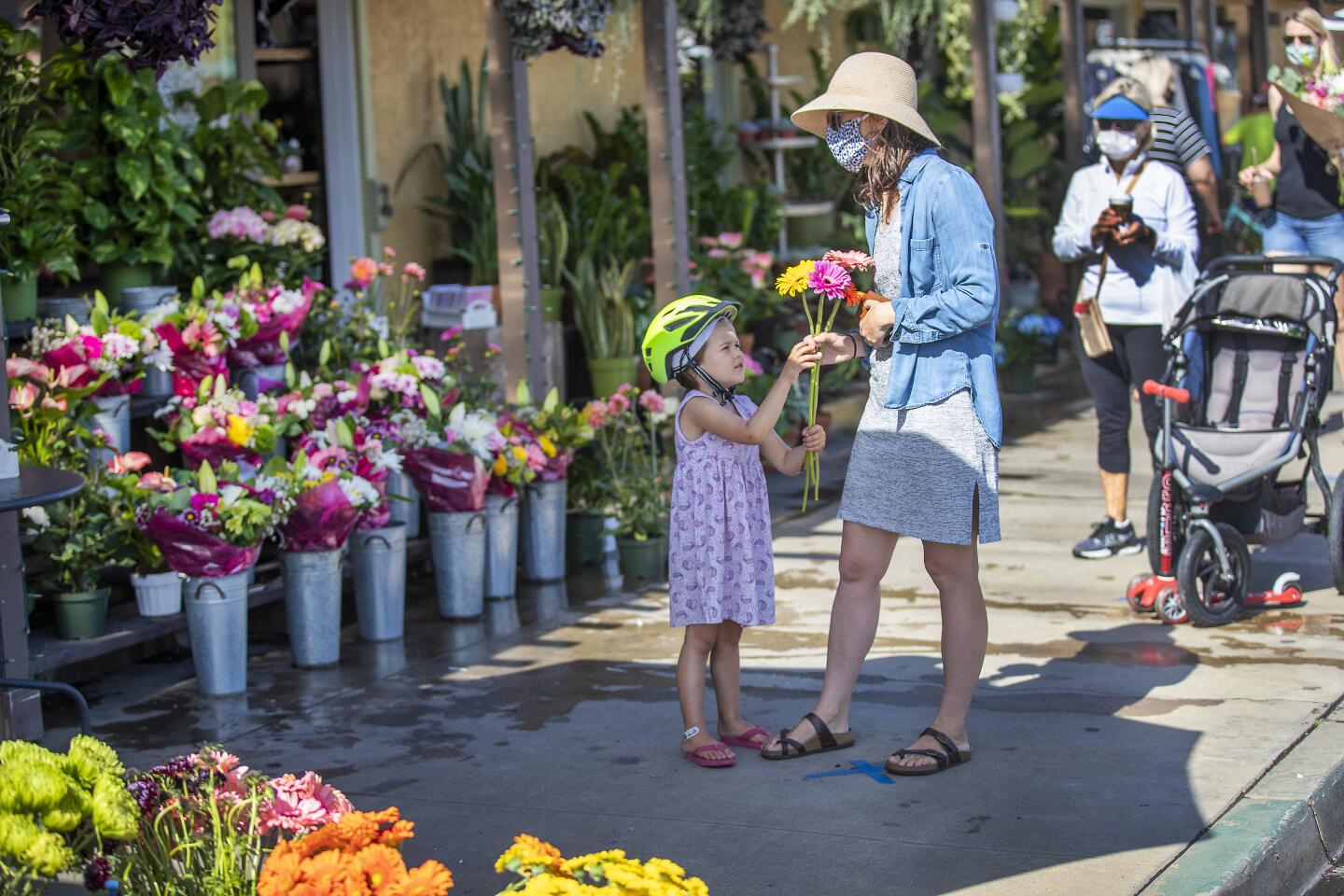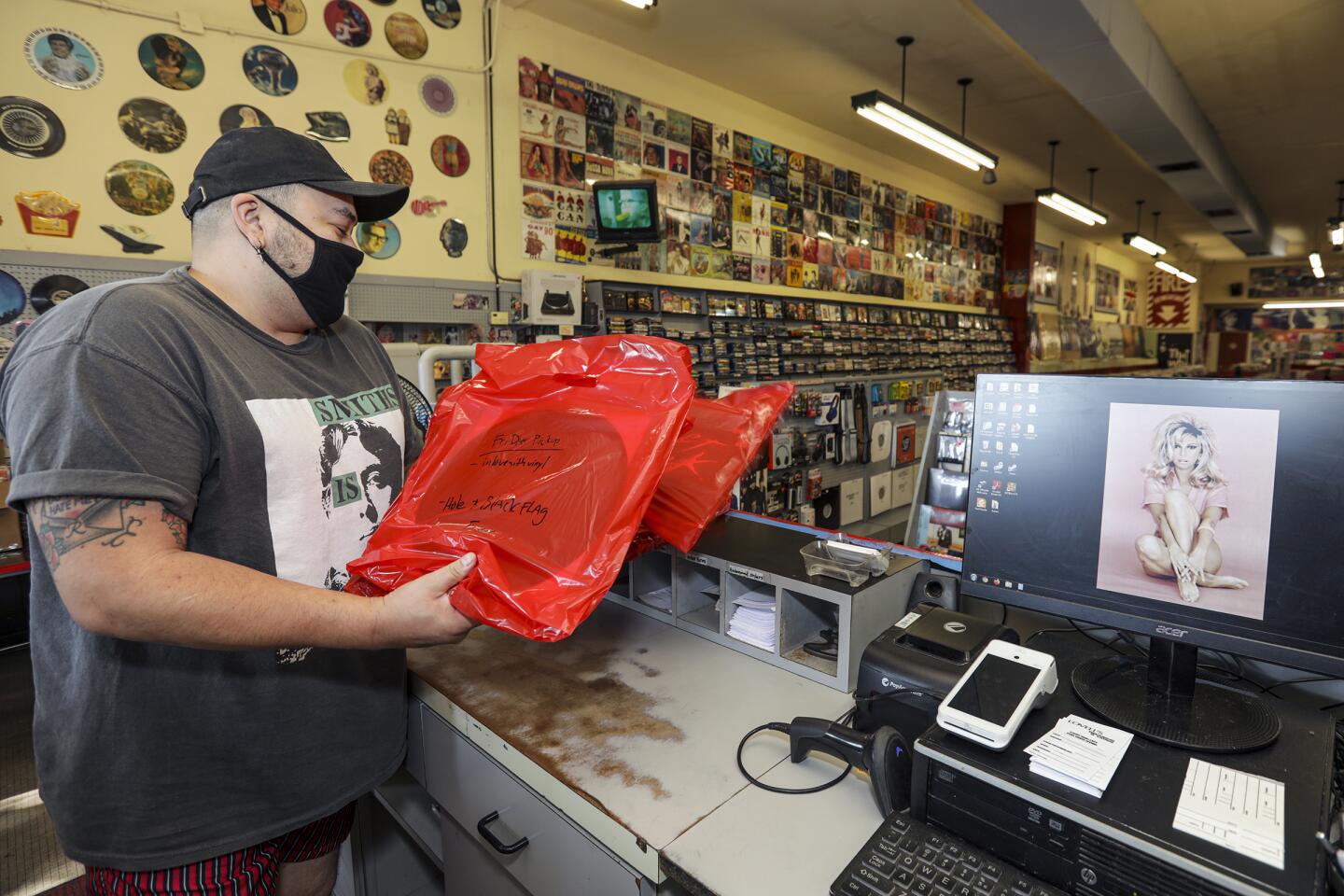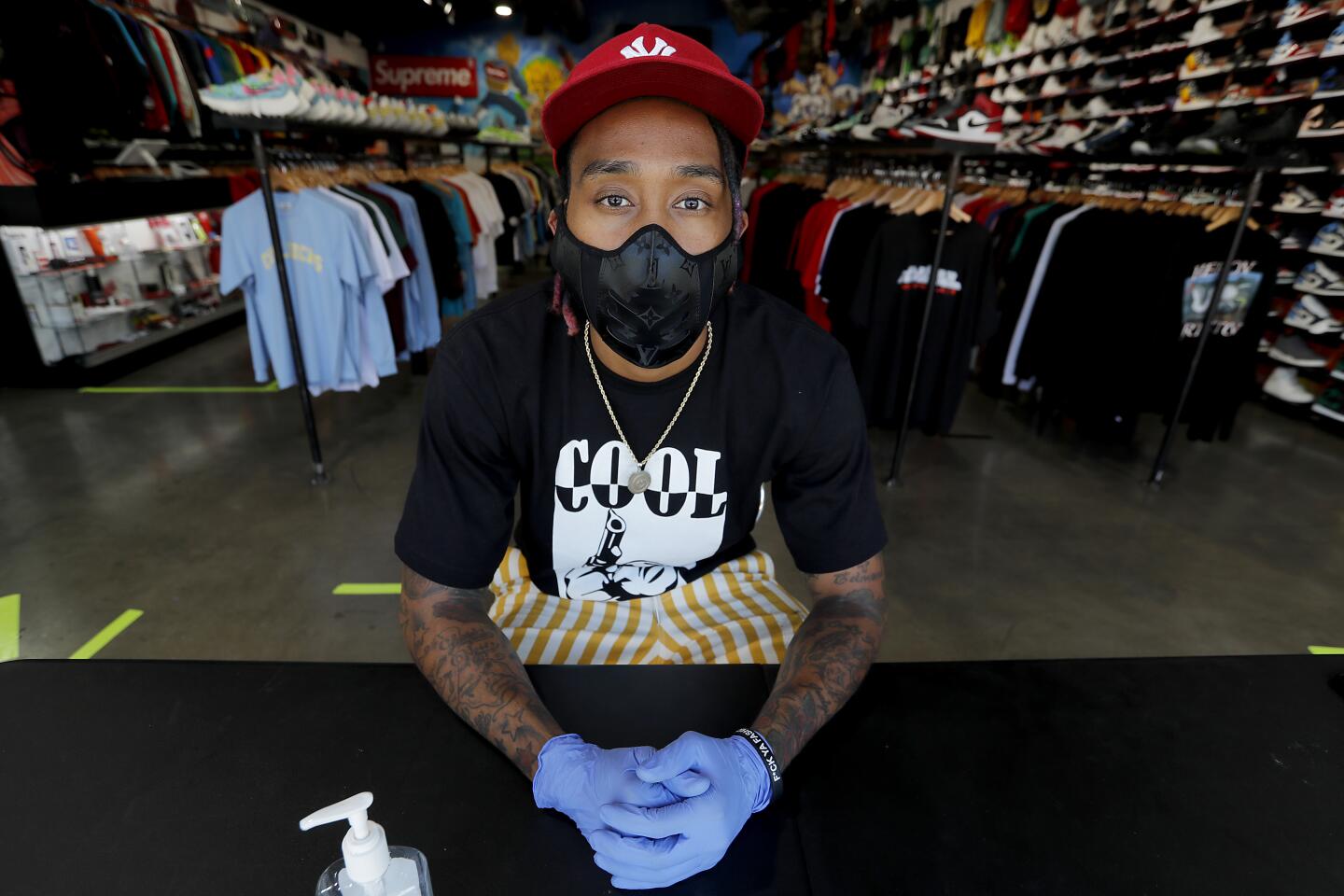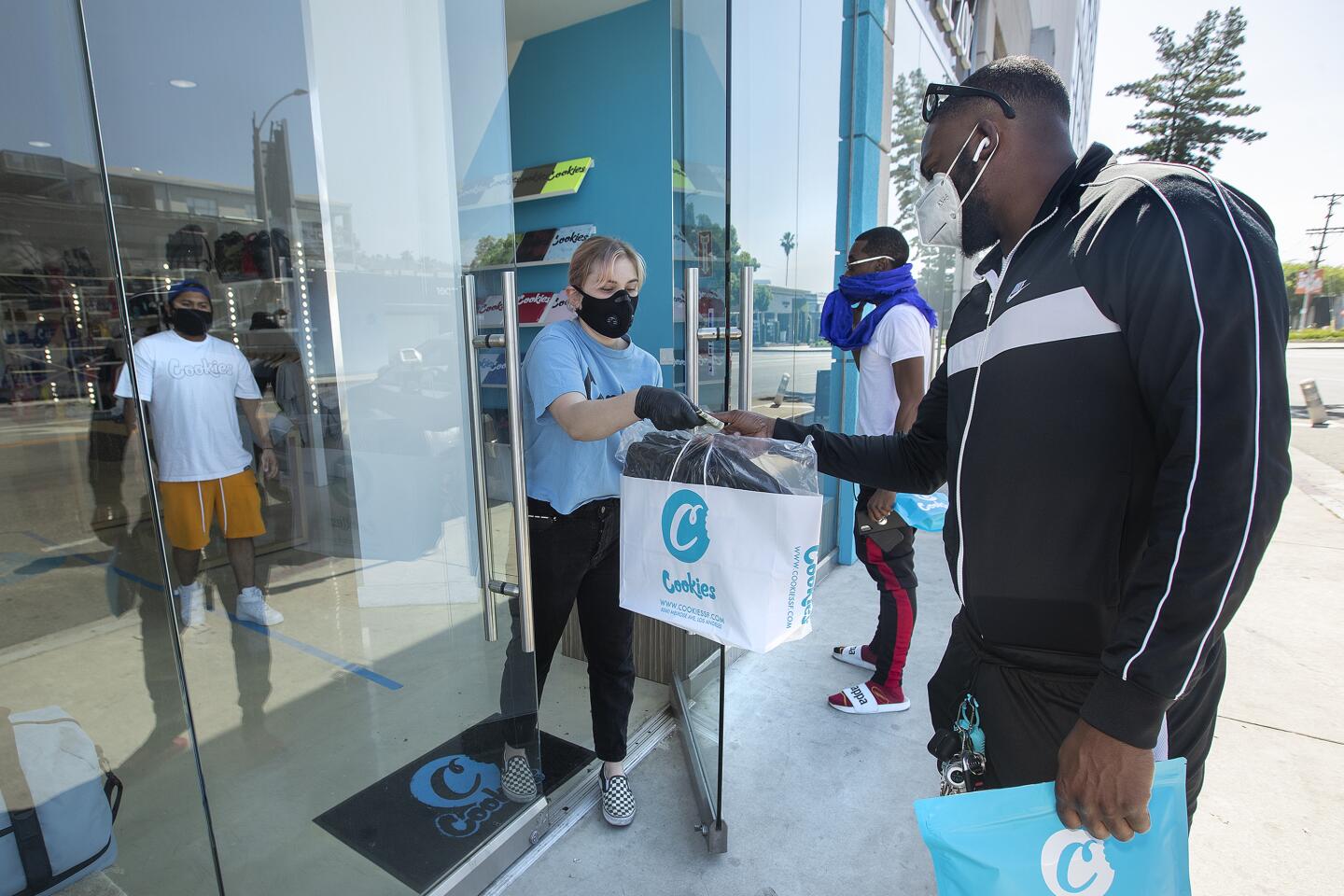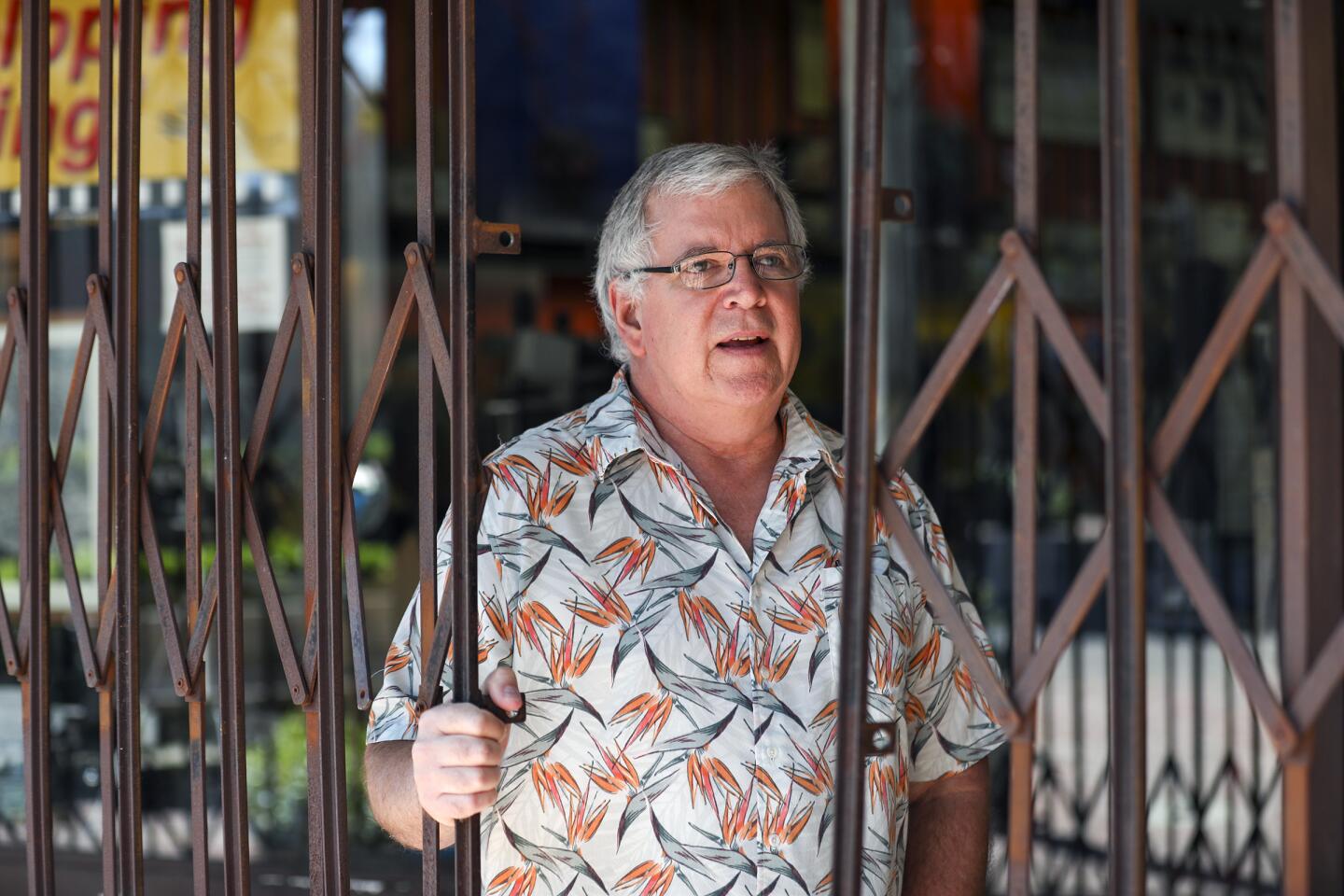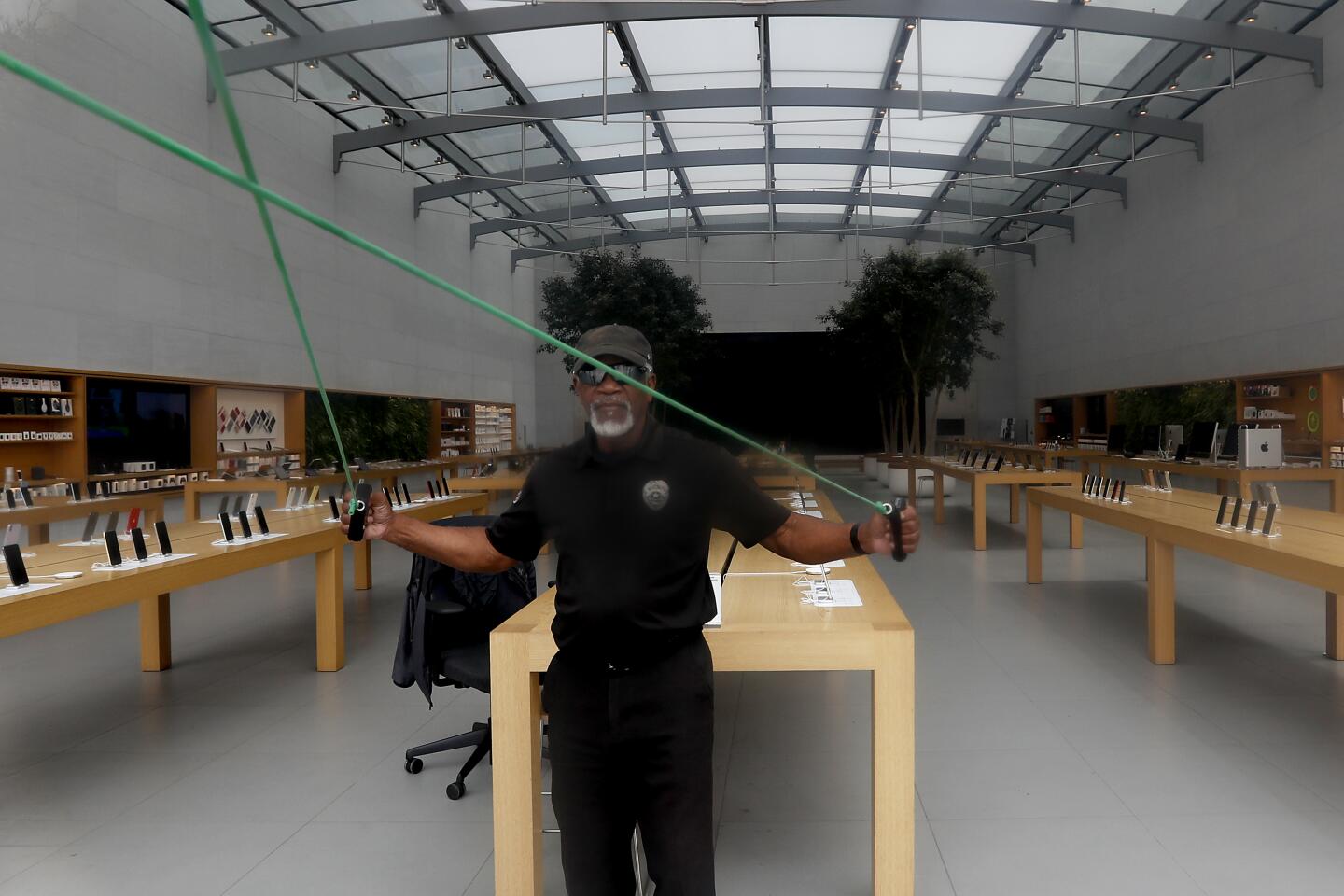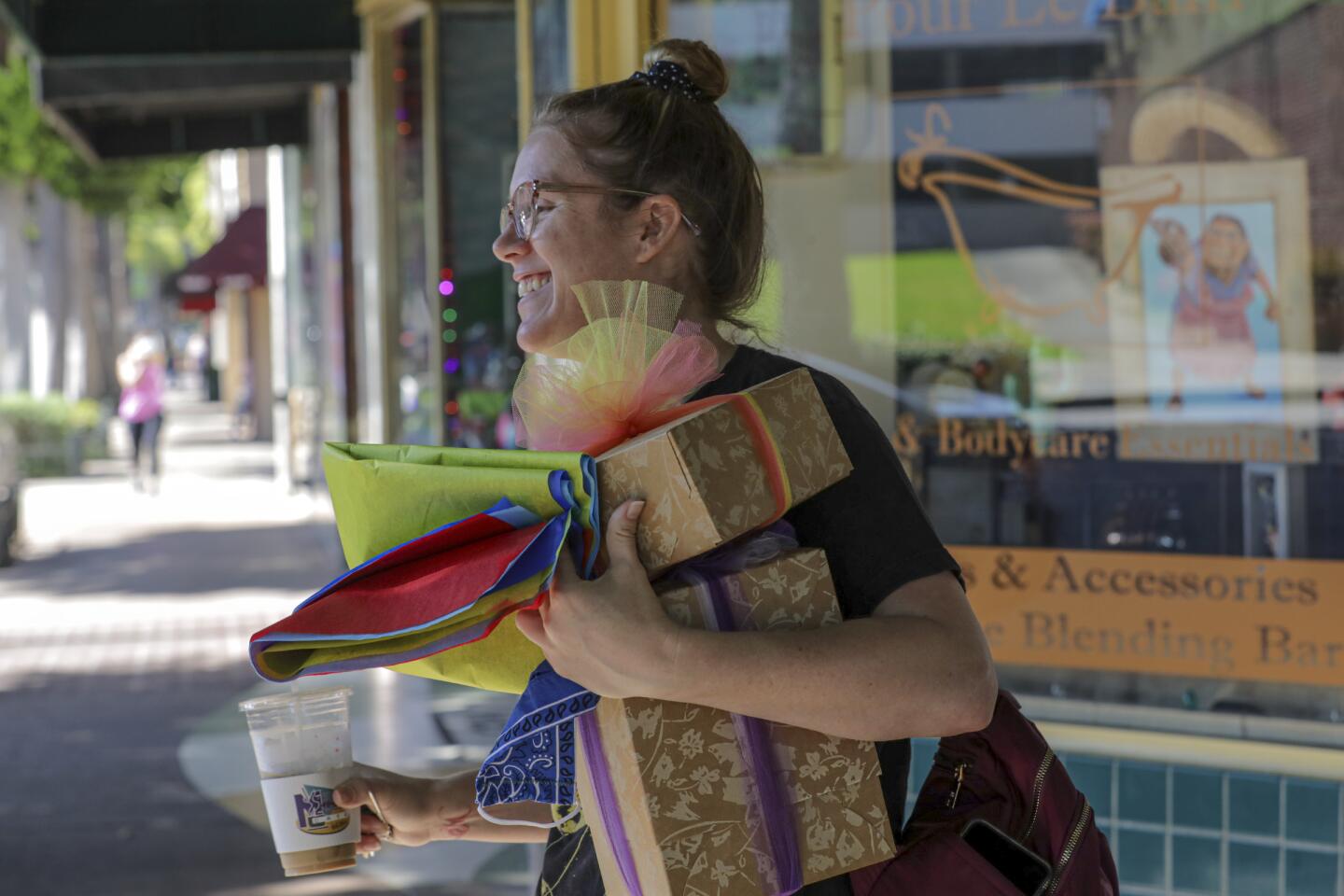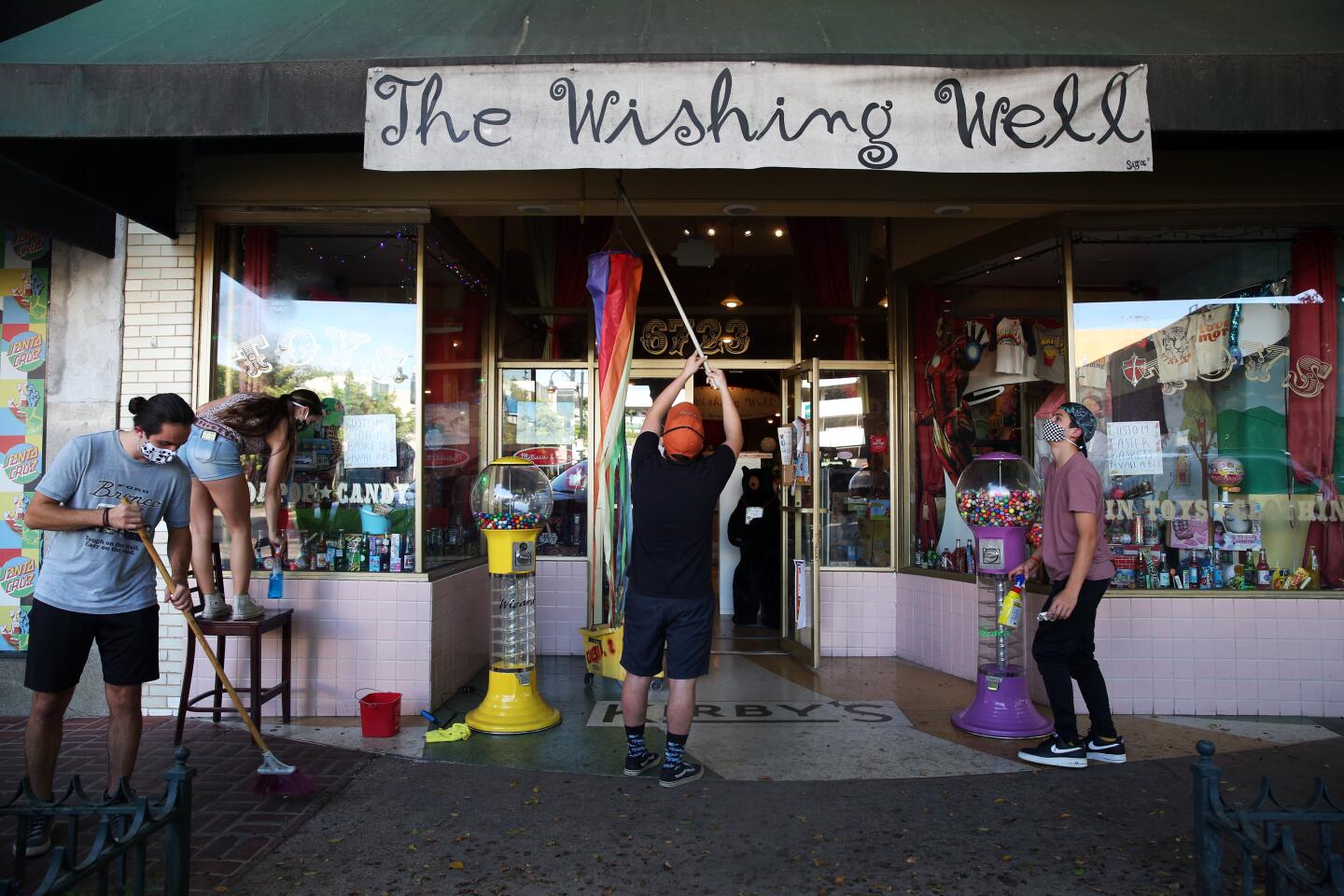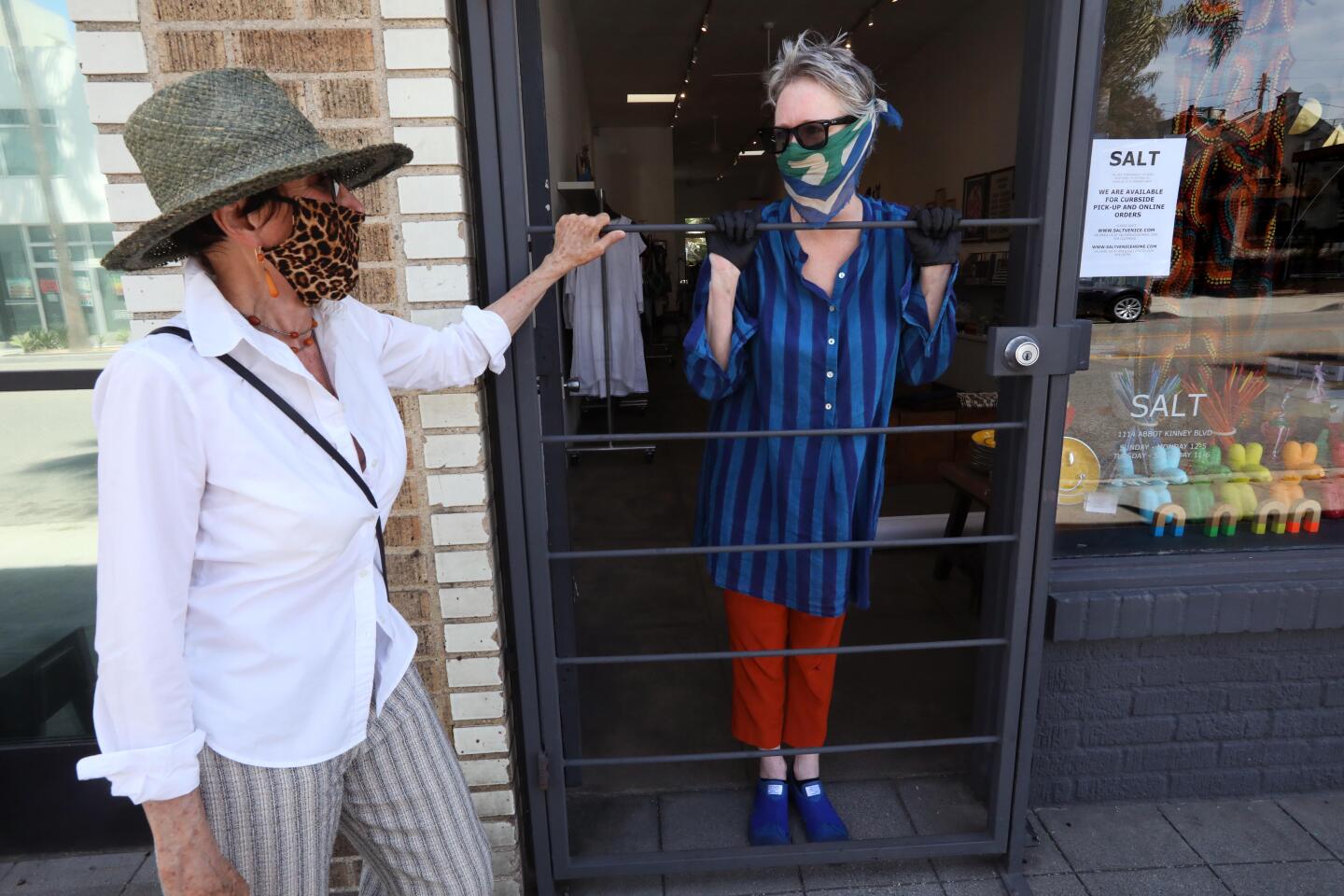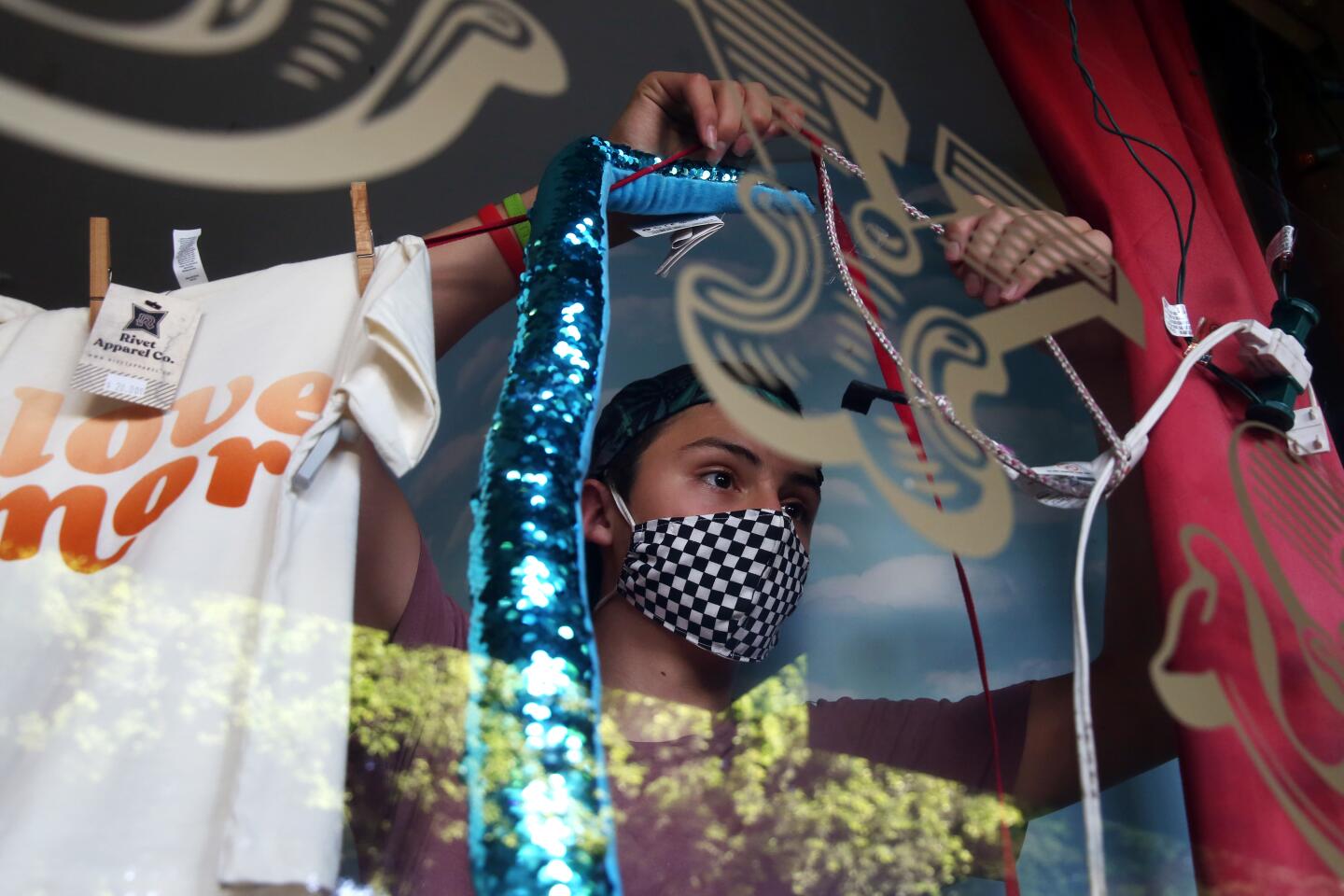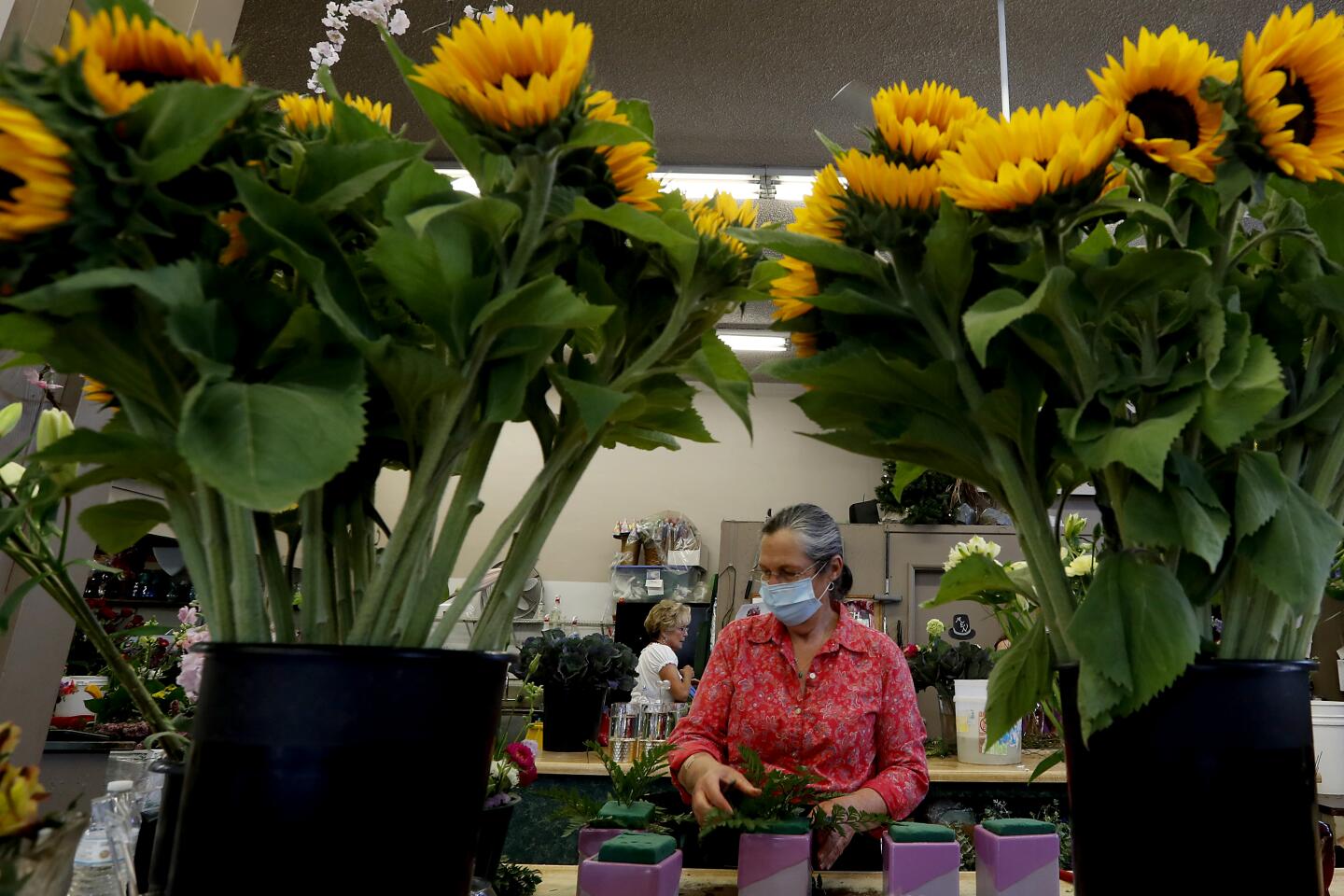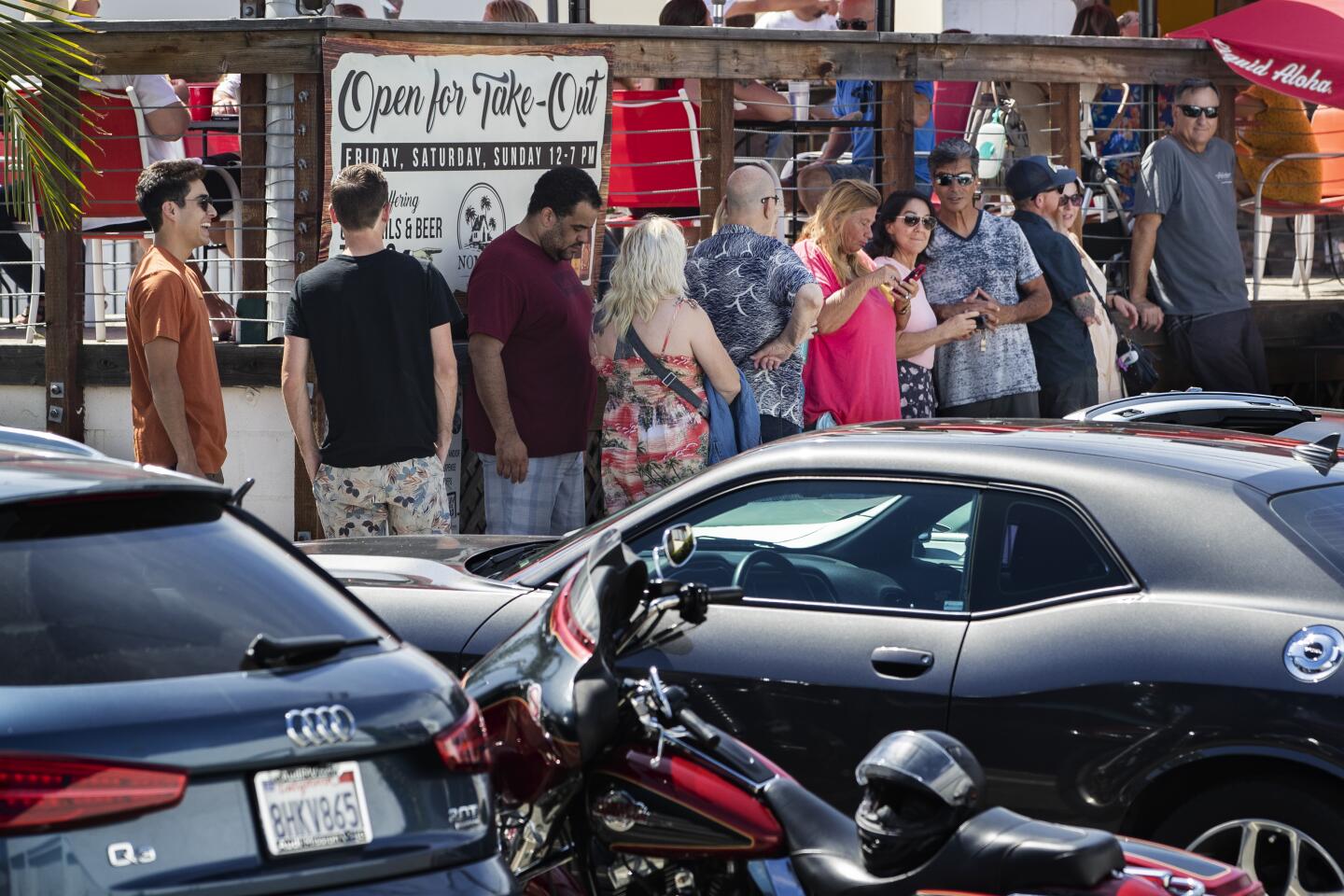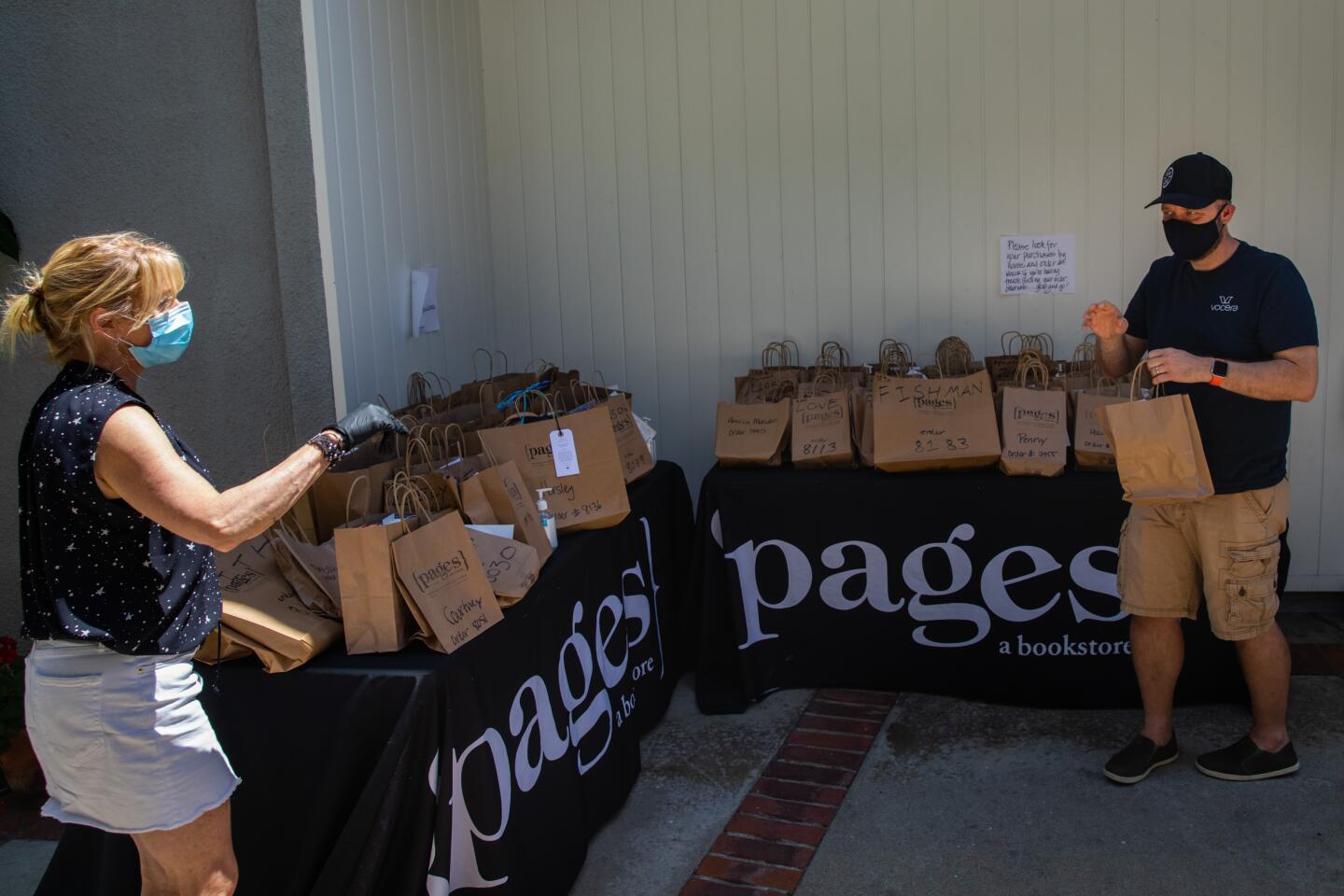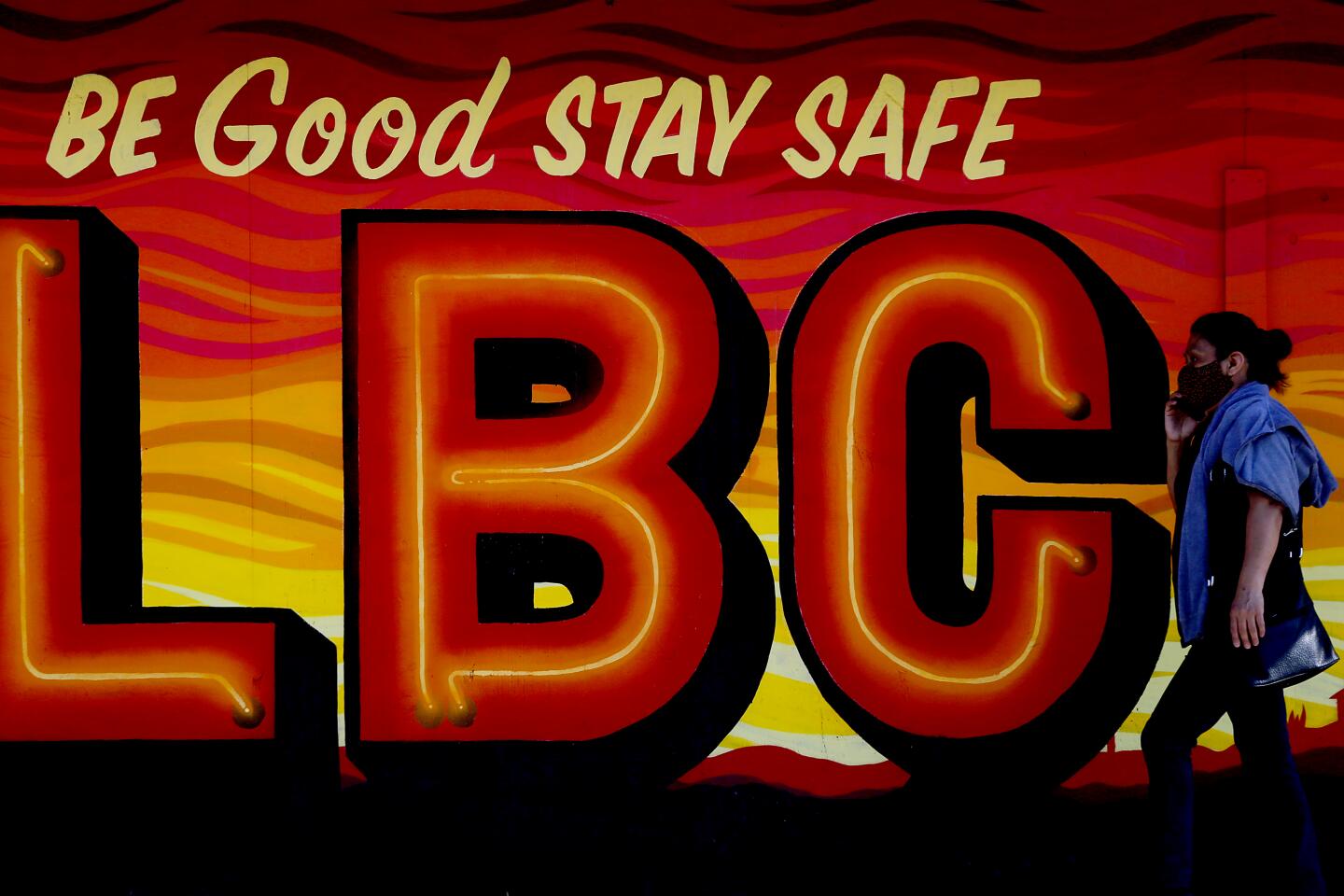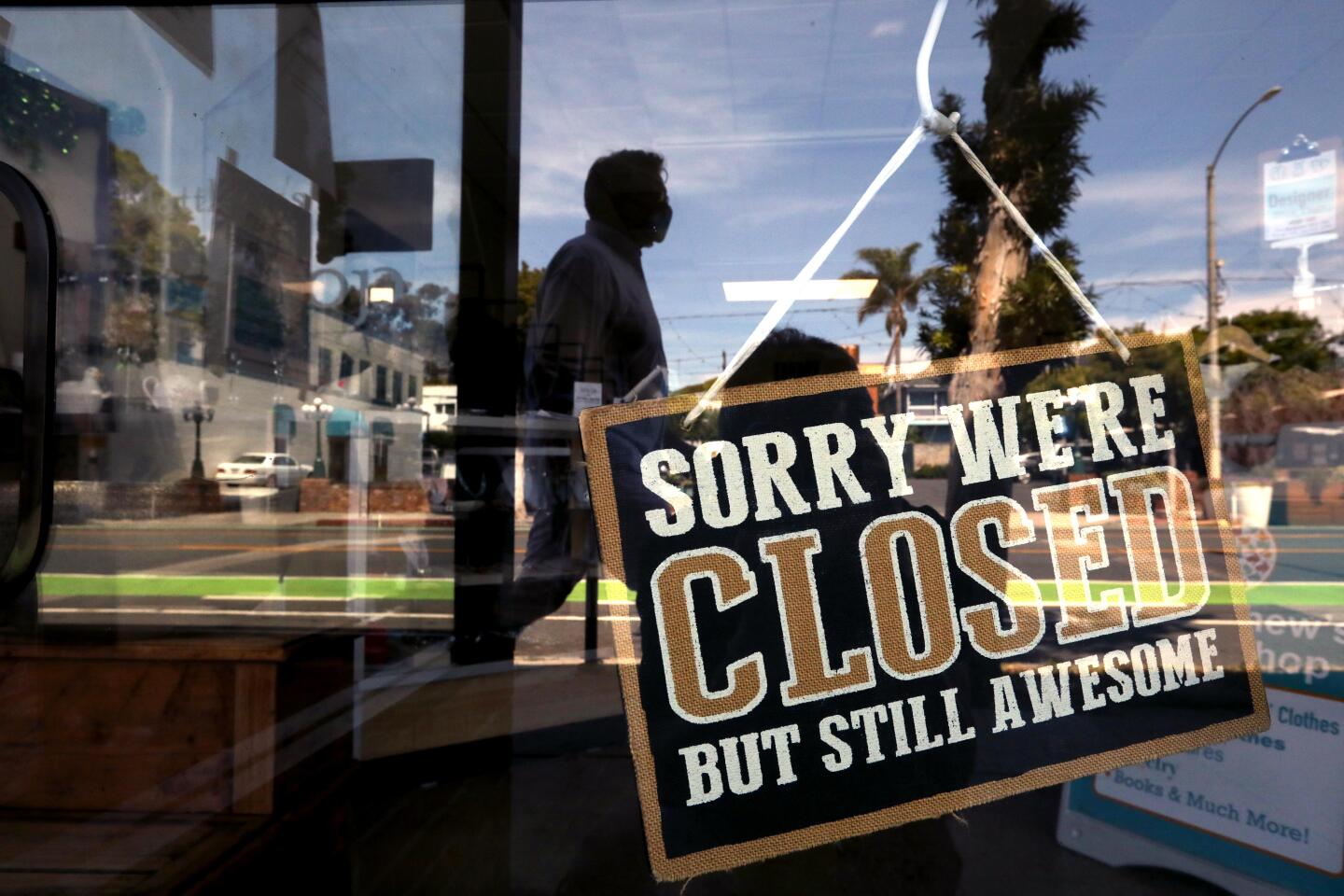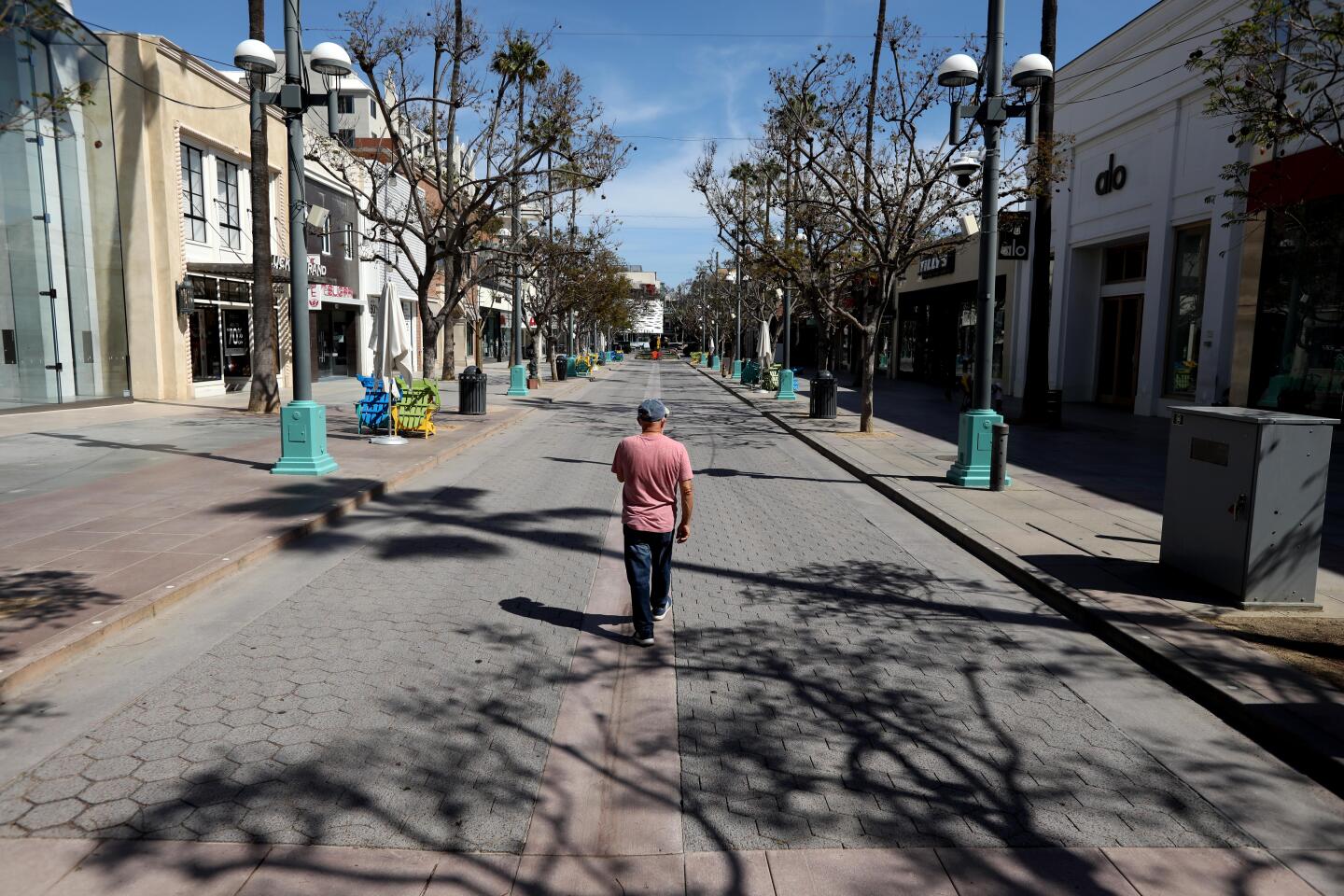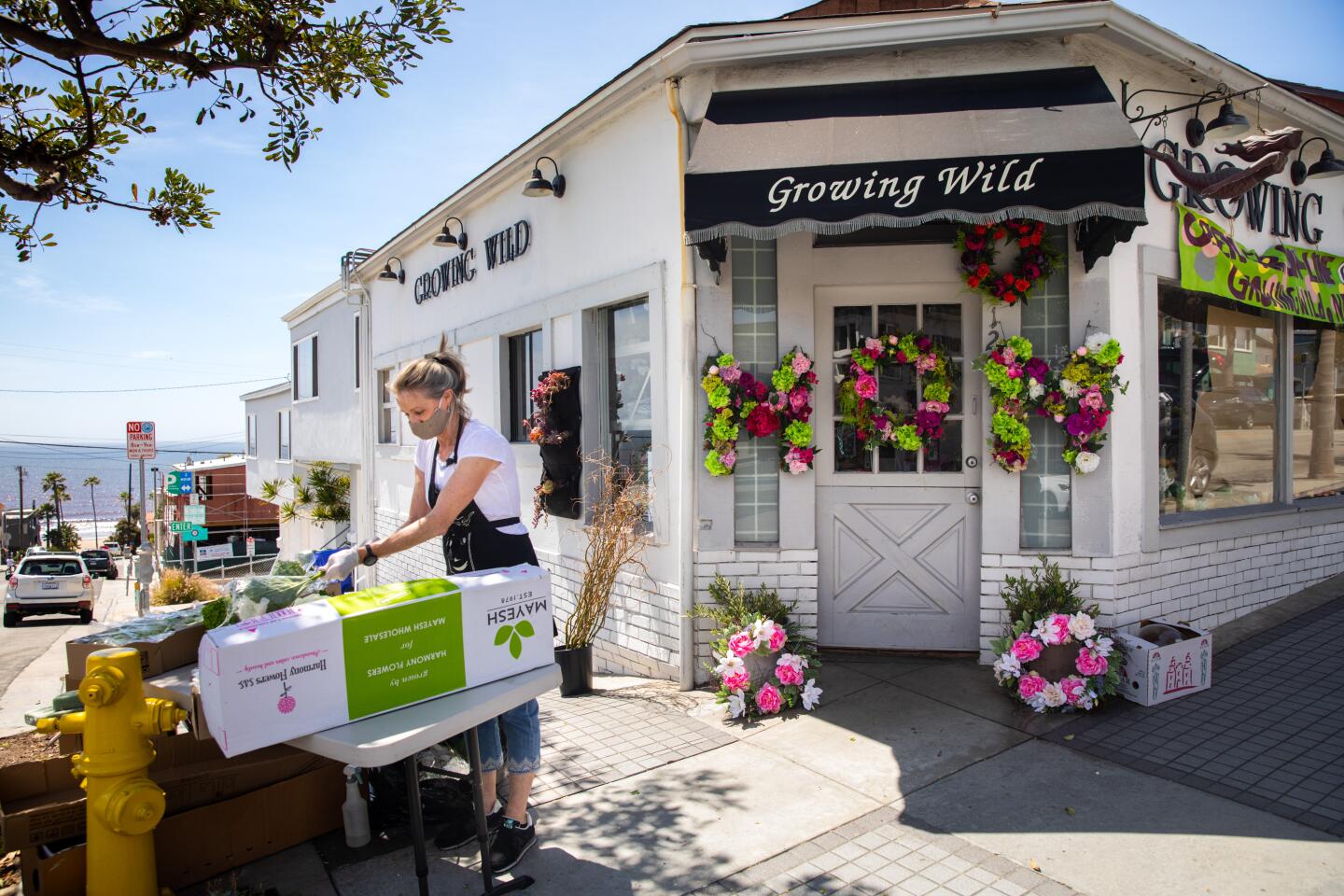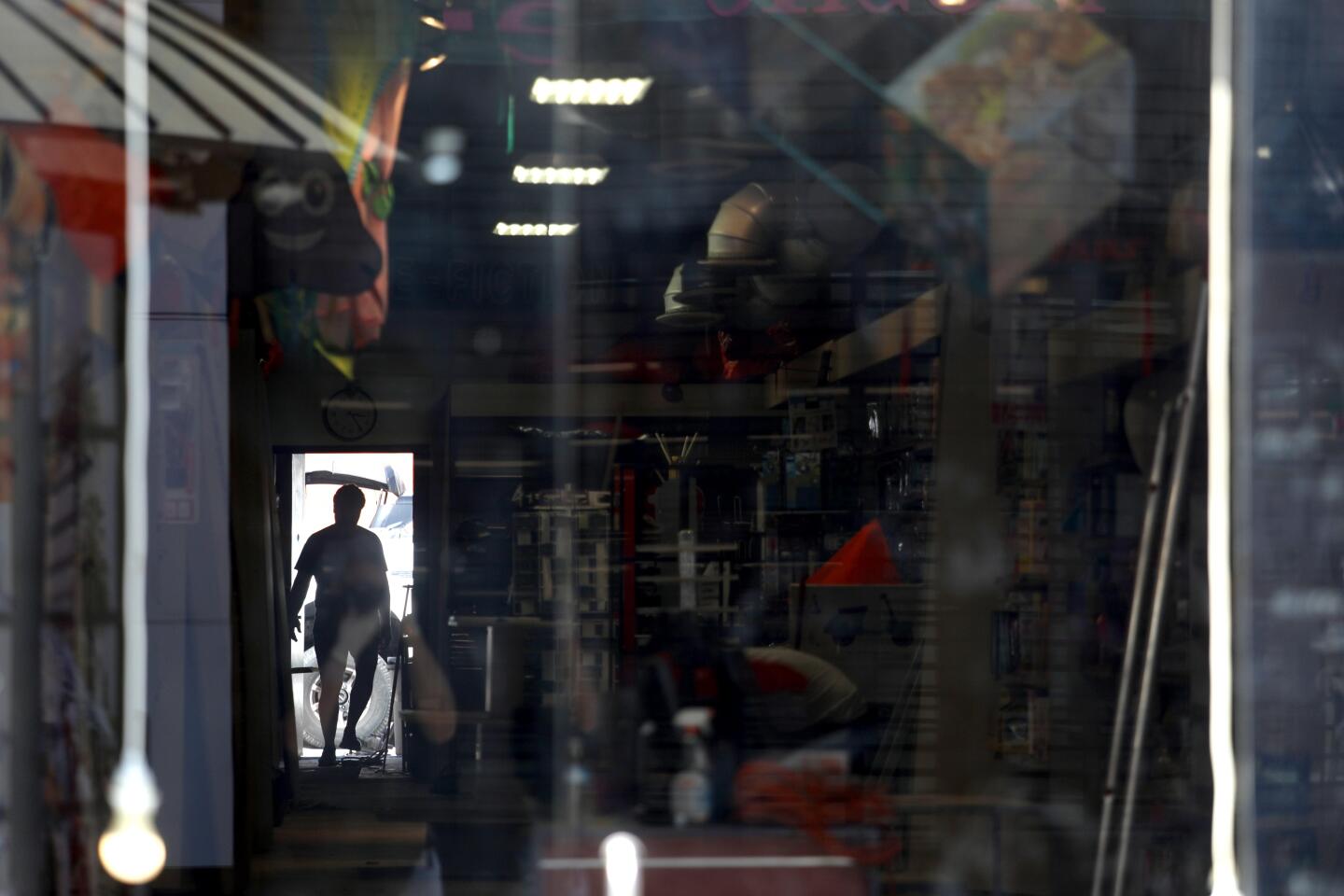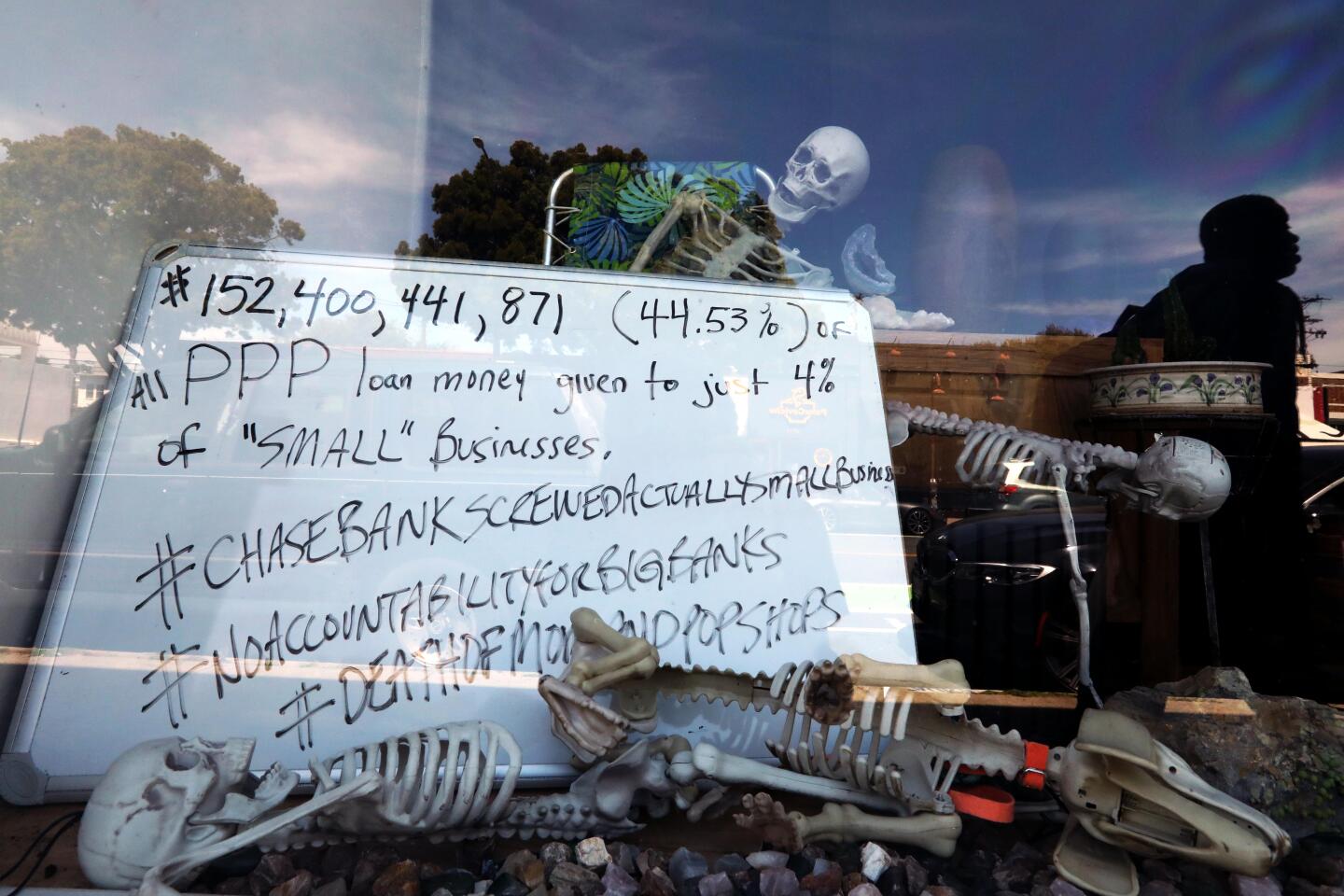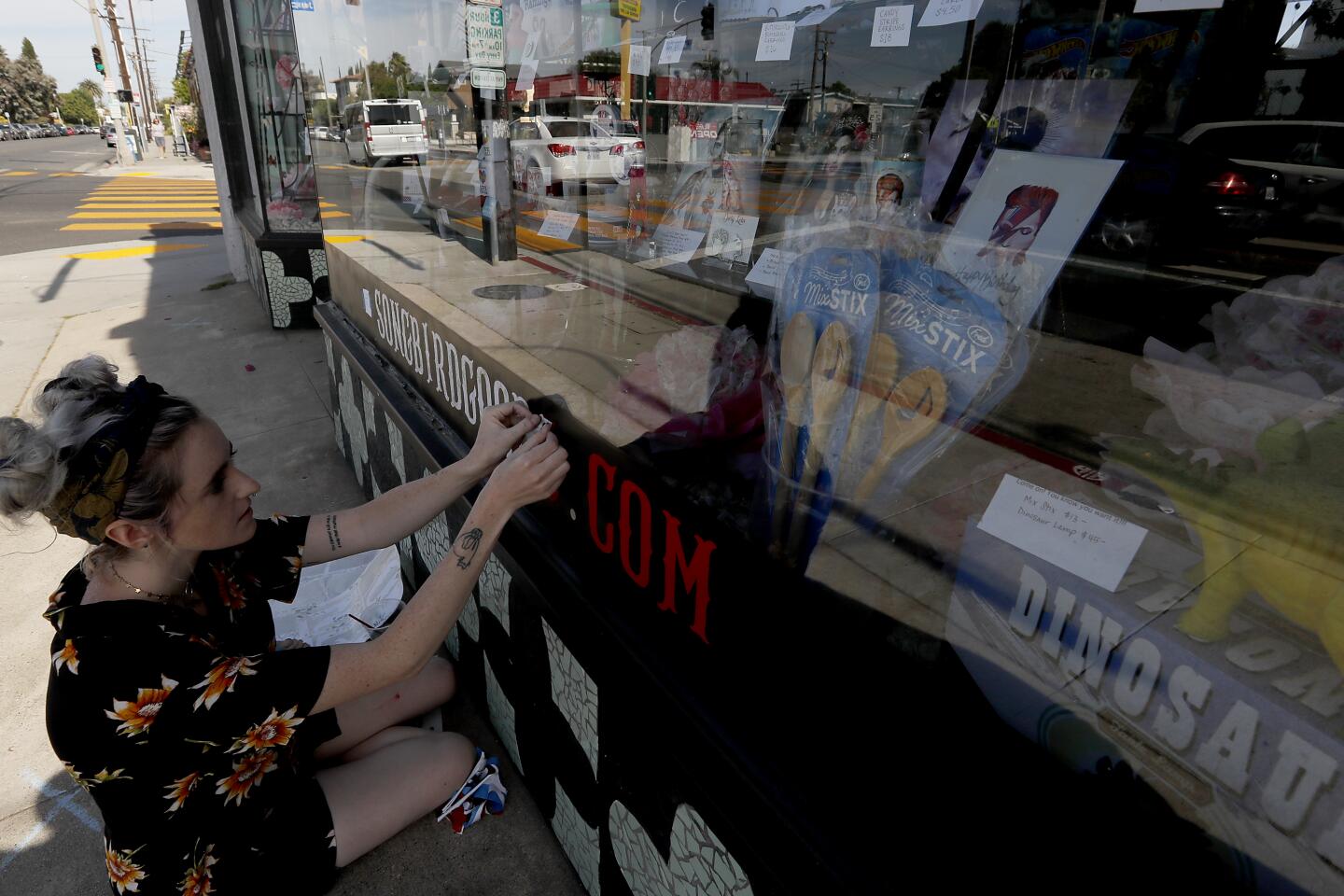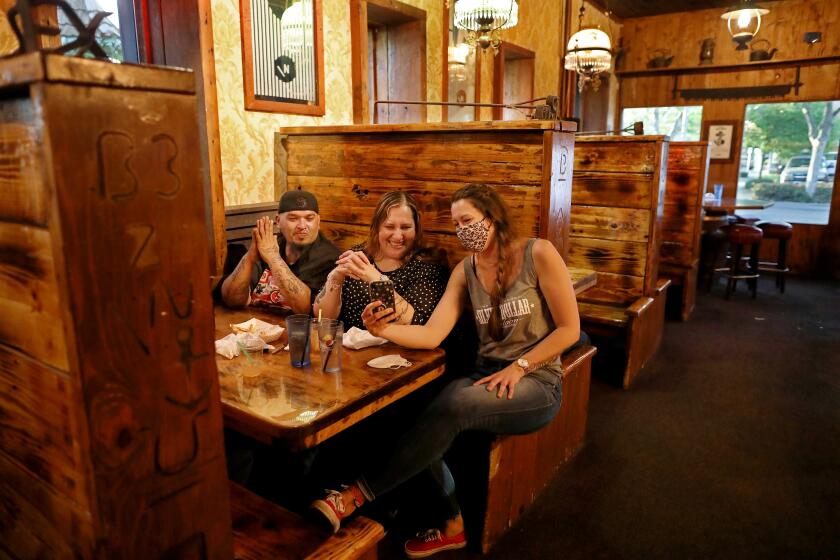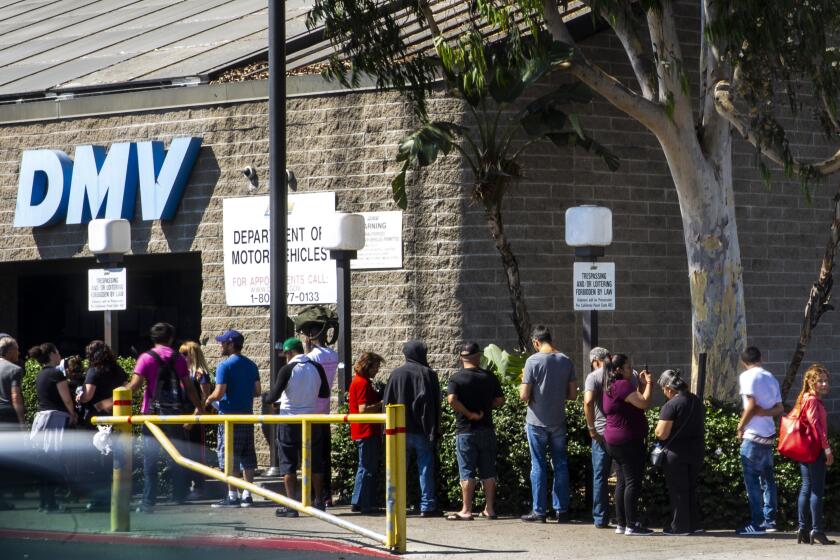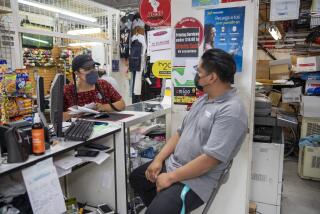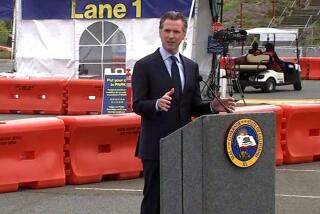Newsom unveils rules governing how quickly California communities can reopen businesses
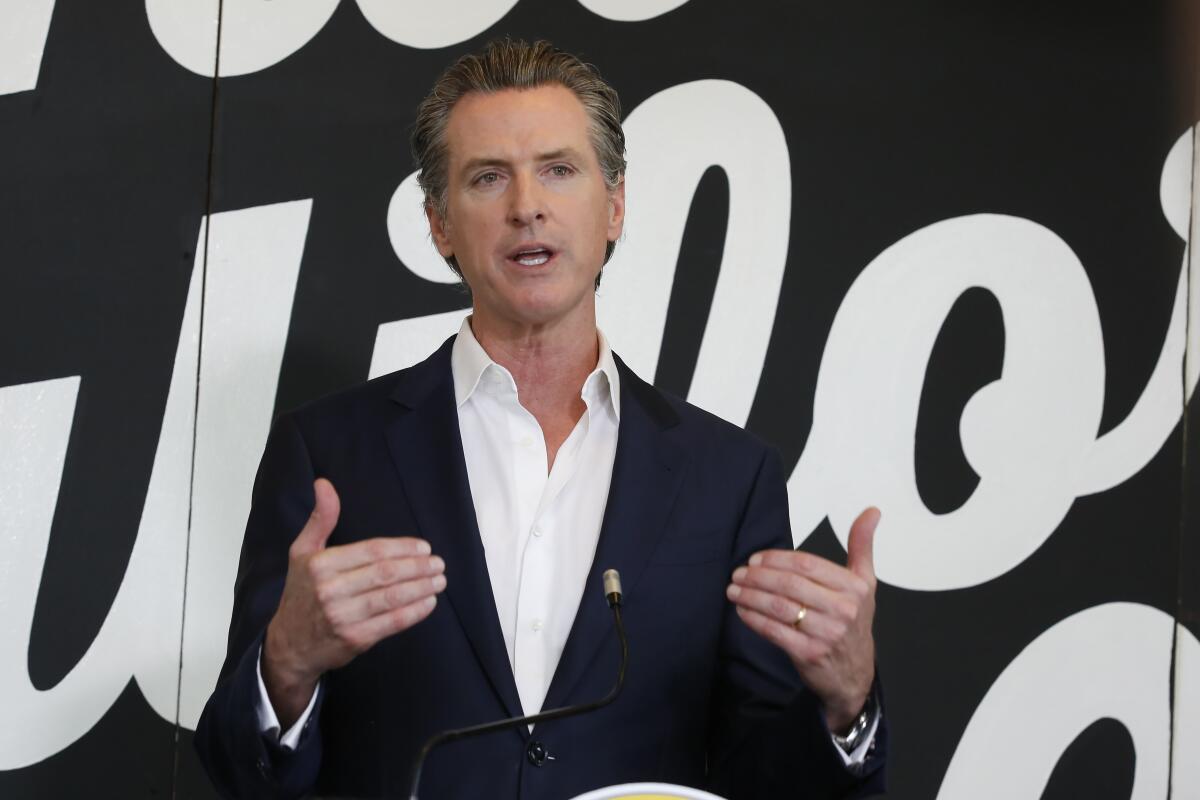
SACRAMENTO — Gov. Gavin Newsom announced new coronavirus safeguards and protocols for retail stores and workplaces eligible to reopen Friday and in the weeks ahead, marking the beginning of California’s gradual easing of the stay-at-home order and attempt to rekindle a state economy ravaged by the COVID-19 pandemic.
Under the plan, in-restaurant dining, car washes, shopping malls and some office buildings could also be allowed to reopen in coming weeks if public health officials in a county are able to demonstrate that the spread of the coronavirus has stabilized there. County officials must prove to the state that they have adequate testing and hospital capacity and the ability to isolate people with the virus, and trace who they have contacted.
Newsom said earlier this week that bookstores, music stores, toy stores, florists, sporting goods retailers, clothing stores and others can reopen for curbside pickup as early as Friday, unless barred by tougher local restrictions. Manufacturers and suppliers that provide goods for those businesses also will be allowed to resume operating.
The state is recommending that retailers continue to encourage physical distancing and implement “hands-free” ways for customers to pay. Manufacturers should close indoor break areas, and warehouses should carry sanitation materials during deliveries and provide employees with personal protective gear, said Dr. Mark Ghaly, the state’s secretary of Health and Human Services.
“We’re moving forward but we’re doing it, always, with an eye being led by the data, by the science, by public health,” Newsom said during his daily COVID-19 briefing in Sacramento.
Before reopening, all retail business are required to create a plan to protect employees and customers, train employees on how to limit the spread of COVID-19, have measures in place to screen for employees who may be ill and implement disinfecting and social distancing policies.
To stem the spread of the coronavirus, which has been blamed for more than 70,000 deaths nationwide, including more than 2,500 in California, Newsom on March 19 signed an executive order requiring the state’s 40 million residents to remain in their homes unless they were classified as essential workers. That came after Californians were urged to avoid mass gatherings and school districts began closing.
The economic toll has been devastating. The state has processed more than 4.2 million unemployment claims since mid-March, when businesses began closing their doors and laying off employees. Newsom’s finance advisors predict the state unemployment rate will hit 18% in 2020.
Nationwide, approximately 33.5 million people have applied for jobless assistance since mid-March.
The Newsom administration, which estimated a state budget surplus of $6 billion in January, now expects one of the largest budget shortfalls in California history.
Newsom’s budget team forecasts a $41.2-billion drop in tax revenue compared to their estimates from just four months ago, with state revenues from personal income taxes, sales taxes and corporate taxes — the state’s main sources of revenue — plummeting by roughly 25%.
The economic impact of the pandemic has put increased pressure on Newsom to begin reopening California and ease his stay-at-home order, and led to some communities in rural Northern California to openly defy the restrictions by allowing businesses to reopen to customers this week, including hair salons, barbers, gyms and restaurants.
These are some of the unusual new scenes across the Southland during the coronavirus outbreak.
Newsom last week laid out a four-stage plan to gradually transition the state back to normal.
His plan expands the authority of some county officials to relax restrictions even further and open more businesses, such as restaurant dining rooms, on a case-by-case basis, a decision to be made in part on the prevalence of the virus in a community. To do so, however, counties must first submit “containment plans” that meet certain requirements for hospital beds, testing kits and the ability to track infected people and trace their contacts.
Ghaly laid out strict requirements for counties that want to move ahead of the state and into the second phase of the plan.
Before implementing those changes, counties cannot have any COVID-19 deaths in the prior two weeks, a high bar that appears to apply equally to counties such as Modoc, with a population of 10,000, as it would to Los Angeles County, home to roughly 10 million. Counties are also barred from moving forward if they have more than one coronavirus case per 10,000 residents.
Hospitals will need to prepare for a 35% surge in patients and adopt plans to protect their workers, Ghaly said. Among other requirements, counties must have at least 15 contact tracers per 100,000 residents to locate and potentially require people to quarantine if they came into contact with infected residents.
Ghaly described the guidelines at the governor’s daily news conference. They include more directives for auto dealers, the construction industry, hotels and other sectors of the economy.
11 photos: Businesses and restaurants open to customers in rural California counties.
“We know that we’re going to gradually reopen California only as we can reduce the risk to all Californians from contracting COVID-19,” Ghaly said.
Still, the state did not provide a detailed description of the specific businesses and activities allowed to reopen Friday or what may be permitted in the weeks ahead.
Some local officials have pleaded with Newsom to allow them to accelerate efforts to lift the stay-at-home restrictions. In San Luis Obispo County, for instance, a bipartisan group of mayors and other political representatives asked Newsom in a letter to allow the county to begin a “science-based, thoughtfully phased reopening of our economy.”
Assemblyman Jordan Cunningham (R-Templeton) said the governor’s promise to give counties more discretion in easing restrictions appears to be such an onerous process that most areas — including San Luis Obispo, which he represents — will not qualify even if they have seen a stabilization or dramatic decline in COVID-19 hospitalizations and deaths.
Cunningham said the state is requiring counties to increase coronavirus testing, which will probably reveal more positive cases. But that would not improve a county’s ability to qualify for a variance to open more businesses if more than one out of every 10,000 residents tests positive in a 14-day period, he said.
“When you go out and test people, you’re always going to get more positive cases,” said Cunningham, who said he supports an aggressive coronavirus testing campaign. “The mere act of doing that is going to disqualify you from reopening. That doesn’t make any sense. I don’t think that that’s good for public health.”
Offices, shopping malls, pet groomers, swap meets and seated dining at restaurants are still ordered closed, but could be eligible to open if a county meets the criteria outlined by the state.
Personal grooming businesses, entertainment venues, live concerts and sports are not included in the second phase of Newsom’s reopening plan.
When asked about the future of sporting events in California this year, Newsom said he doubted fans would be filling any stadiums until a vaccine is developed for the coronavirus.
“It’s difficult to imagine a stadium that’s filled until we have immunity, until we have a vaccine. It’s difficult for me and imagine what the [National Football League], broadly leagues, do,” Newsom said.
The order to stay home unless venturing out to grocery stores, hospitals, vet appointments and other necessary trips also remains in effect.
John Kabateck, the California director of the National Federation of Independent Business, praised Newsom’s reliance on recommendations from his public health advisors to drive his plans to reopen the economy in the safest way possible.
The financial costs of the statewide restrictions, however, also come with devastating consequences to workers, families and business owners and cannot be dismissed, he said. Small business owners have been critical of Newsom’s plan, noting that big-box stores such as Walmart, Target and Costco are allowed to serve customers inside their stores while mom-and-pop stores must stay closed or offer only curbside pickup.
“Restaurants are crumbling. Retail stores are devastated. And the people who work there are struggling to feed their families and make ends meet,” said Kabateck, whose organization represents 15,000 small businesses in California. “They hope and pray that all small businesses can have a system and structure to turn their lights on very, very soon.”
Kabateck urged Newsom and state lawmakers to avoid burdening small business owners with new laws and workplace requirements that impede their ability to reopen. For instance, the expanded workers’ compensation rights Newsom announced on Wednesday probably will drive up costs on small businesses that already are struggling to survive.
The economic impact of the statewide expansion to curbside pickup and delivery could be limited, especially for small businesses.
Some national retail chains were beginning to introduce pickup options before the pandemic hit, while others have continued to rely on their online presence to bring in sales under the restrictions, said Rachel Michelin, president of the California Retailers Assn.
But small businesses that don’t have an online sales system may struggle to modify their model to offer pick up, she said.
California DMV will reopen 25 field offices after shutdown
“It really isn’t going to help those small businesses because they’ve been closed for seven or eight weeks and they don’t necessarily have the capital to invest in the infrastructure you need to take advantage of the curbside,” Michelin said. “You have to be able to set up your website, have a payment option and all of that stuff that costs money when people have been closed.”
Michelin commended the governor for making changes to help retailers and said she hopes counties will begin to craft plans to expand beyond the state guidelines and allow stores to safely open for in-person shopping.
Regardless of Newsom’s Thursday announcement, leaders in Los Angeles and the San Francisco Bay Area have said they plan to take a cautious approach to reopening because the coronavirus remains a significant public health threat in those metropolitan areas.
“The numbers are still going up,” San Francisco Mayor London Breed said. “The number of deaths are still going up, and we have not lowered the curve, and we have to be mindful of that.”
Los Angeles County remains the primary COVID-19 hot spot in California, with more than 1,300 deaths and 28,000 confirmed cases, including about 800 new cases reported on Wednesday alone.
Meanwhile, Yuba and Sutter counties in Northern California decided to allow businesses, including restaurants and hair salons, to reopen on Monday as long as they adhere to certain safeguards and restrictions. Dr. Ngoc-Phuong Luu, health officer for Yuba and Sutter counties, issued the order in part because the region has not been hit hard by the virus.
Assemblyman James Gallagher (R-Yuba City) said the health office made the decision after consulting established public health guidelines, including those issued by Johns Hopkins University, one of the top research institutions tracking the virus.
Instead of criticizing Yuba and Sutter counties, the Newsom administration should explain why it decided to restrict most retailers to providing only curbside pickup instead of allowing customers in stores, as well as why businesses that provide personal services should remain closed, Gallagher said.
“The question to the state, to the governor and Department of Public Health is what’s your authority for saying that they can’t,” Gallagher said. “I mean, is that your own guidance? Or is it an evidence-based, peer-reviewed guidance?”
More to Read
Sign up for Essential California
The most important California stories and recommendations in your inbox every morning.
You may occasionally receive promotional content from the Los Angeles Times.
